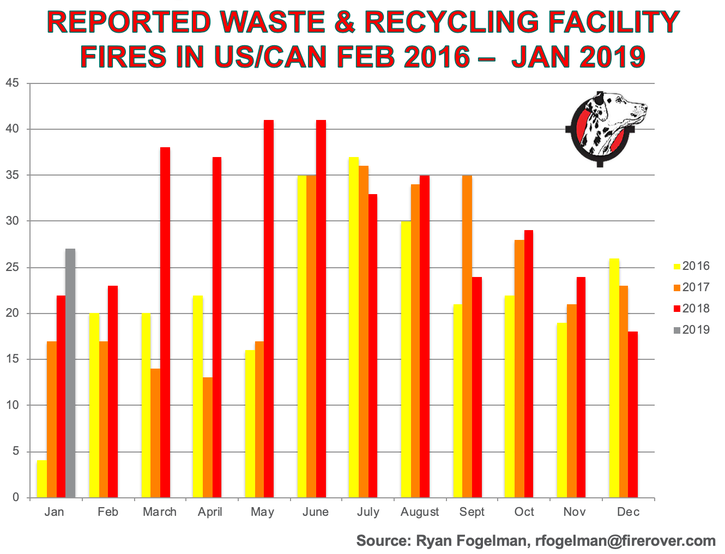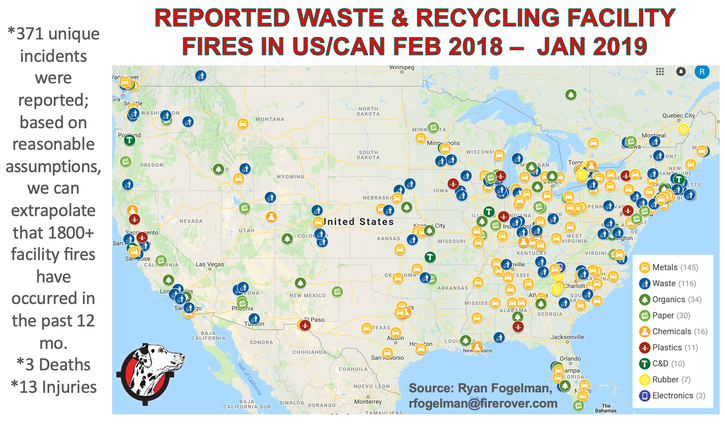January 2019 Waste, Recycling Facility Fire Incidents Take a Turn for the Worse
This January, reported fires have increased from 17 incidents in 2017 to 27 incidents reported this year.

During the past 12 months, the waste and recycling industry has experienced 371 reported fires in both the U.S. and Canada. Based on reasonable assumptions, we can extrapolate that 1,800-plus facility fires have occurred during that time, which based on the number of facilities reported by the Environmental Research & Education Foundation (EREF), is more than 40 percent of the industry.
There were also three deaths and 13 injuries reported during that time. Most of these injuries are suffered by the brave fire professionals called in to fight and contain these incidents.

After a year where we saw a 26 percent increase in reported fire incidents in waste and recycling facilities, we ended 2018 on a positive note, where December’s reported fires have been in steady decline from a high of 26 incidents in 2016 to a low of 18 incidents in 2018. Unfortunately, we have seen the reverse trend this January, where reported fires have increased from 17 incidents in 2017 to 27 incidents reported this year.
These fires are not only occurring at our materials recovery facilities (MRFs) and transfer stations but at our scrap metal, construction and demolition (C&D), paper, plastic, chemical and organics recycling operations and are caused by a list of fire hazards, including, but not limited to, lithium-ion batteries, pressurized tanks/containers, fuels, fertilizers, propone tanks, aerosols and more.
Most fires are caught during their very early stages, but as one can imagine, the fires that are being reported by news outlets have typically passed the incipient stages. Most of these incidents incurred significant damage and downtime and are required to be fought by our local firefighting professionals.

Causes of these fires range from traditional material hazards such as pressurized tanks, chemicals, hot work activities, hazmat and smoking to newer hazards like lithium-ion batteries. No matter what the cause or what the risk, even the best operators are not able to completely eliminate their risk of fire. It is imperative that they develop and continuously revisit their fire plan. The proper defense consisting of training, operations, equipment and technology can mean the difference between getting a fire incident under control early versus the alternative of a complete shutdown.
I met with Paul Kuhar from Champion Waste based out of Dallas to get his thoughts around the fire protection and prevention both in the industry and at his sites. As Kuhar and I spoke, I bulleted a number of key highlights he mentioned during our conversation:
As C&D, commercial and residential recycling continues to advance, so does technology and the potential opportunities outside the normal box of services we provide as operators.
Recycling plant fires are something that every operator is faced with on a daily basis, and we must take the necessary prevention steps to ensure they do not occur.
Traditional MRFs are always at risk; however, other recycling facilities are faced with those same risks as well because of the potential items that can be placed in any load.
Education and communication are the first steps in prevention with customers on the collection side as well as those who deliver material to your facility. Specifically, customers must understand what can be recycled and what is considered nonrecycled or unauthorized materials.
Each MRF must have its own procedures in place for dealing with unauthorized waste to help eliminate the potential threat of a fire. “At Champion, we have additional steps in place such as load inspections that are performed on the arrival of each load to ensure the quality and safety of each load entering our operation.”
Fire prevention is something that should never be taken lightly regardless of the size of your recycling facility or type.
Stay abreast of new fire prevention technology available and making the proper investment in both safety and business continuity.
When thinking of making an investment in fire prevention safety, think about this one, simple truth: “It only takes a spilt second to change everything as we know it.” Never underestimate the value of being educated, prepared and trained for an event you thought would not happen to you.
If you have interest in learning more about the C&D side of the business, I would suggest attending C&D World, which will be held March 9-12 in Brooklyn, N.Y. Kuhar will moderate a fire safety panel that will include myself, John Schumacher from Assurance and Jim Emerson, a highly trained fire engineer with Starr Technical Risks Agency. The panel will focus on understanding how to mitigate the risk of fire in your operation from the insurance perspective, specifically focused around the Combinational Approach to planning for a waste and recycling facility fire.
Ryan Fogelman, JD/MBA, is vice president of strategic partnerships for Fire Rover. He is focused on bringing innovative safety solutions to market. He has been compiling and publishing the “The Reported Waste & Recycling Facility Fire In The US/CAN” since February 2016 and the “Waste & Recycling Facility Fire Annual Report.” Fogelman speaks regularly on the topic of the scope of fire problems facing the waste and recycling industries, detection solutions, proper fire planning and early-stage fire risk mitigation.
About the Author
You May Also Like




